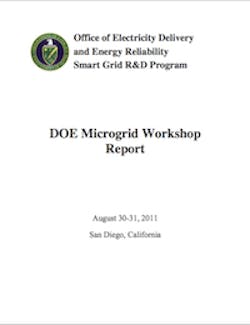A workshop planning committee with representatives from the national laboratories involved in microgrid initiatives was assembled to develop the workshop process and sessions. Additionally, the committee members provided nominations of experts and practitioners to the DOE for invitation to the workshop. The workshop had a total of 73 registrants, representing vendors, utilities, national laboratories, universities, research institutes, and end users. The technical topic sessions were jointly conducted by some of the committee members as well as industry co-leads.
The first day of the workshop consisted of an opening plenary session followed by two breakout sessions run in parallel. Breakout Group 1 (blue) focused on microgrid components under the following subtopics: switch technologies, control and protection technologies, and inverters/converters. Breakout Group 2 (red) focused on microgrid systems under the following subtopics: standards and protocols, system design and economic analysis tools, and system integration. The second day of the workshop consisted of a combined session in which the selected industry representatives reported the summary of their sub-sessions to the entire group. The report-out presentations consisted of priority R&D areas and their performance baselines, targets, and actionable plans
